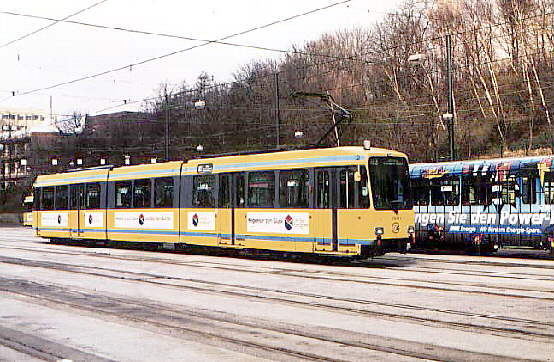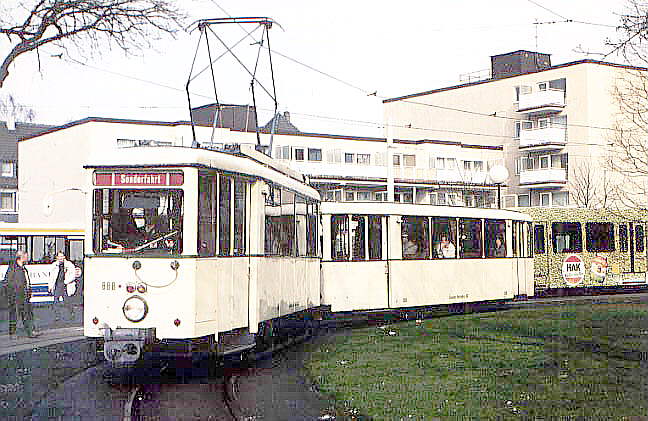
From 1960 some tram lines were closed with others converted to
underground
light rail called Stadtbahn. To date two underground lines have been
built, going from the Northeast to the Southwest and from the
Northwest to the Southeast of the city. The east-west line is still on
the surface, as is one short north-south line. By 2005 there will be
three lines underground in the centre of the city, continuing as
normal surface tramways in the suburbs.
Three generations of cars are in use, all of them double-ended: The
GT8, dating from 1959, will be retired in the next two years as they
are not able to run in a tunnel. The successor of the GT8 was the N8C,
introduced in 1980. Both GT8 and N8C are 2.30 m wide high-floor cars
with steps for boarding. The latest generation of cars are the wider
(2.65 m) B80C Stadtbahn cars dating from 1986. They serve both
underground north-south lines, while the N8C and the few remaining GT8
handle the other lines. The B80C Stadtbahn cars normally provide level
loading from high platforms. From the end of 1996, some B80C cars were
extended with an additional segment in the middle, making it an
eight-axle-car. Those cars are now called B8, while the old six-axle-cars
are renamed B6. Low-floor-cars are expected to ultimately replace the N8C
cars on the east-west line.
At Dortmund University, there is a monorail, called H-Bahn, connecting
the northern and the southern campus, with a branch-line to the S-Bahn
(railway) station. You can see the current operations and the
timetable of the H-Bahn.

The original plan from the 1960s was to close many metre-gauge light
rail-lines and to convert the important ones to Stadtbahn with some
underground sections. This policy was stopped by high costs and only
one more line to Altenessen and Karnap is being built for year 2001
opening. Today, there are three Stadtbahn-lines: U11, U17 and U18. U11
runs south of the Hauptbahnhof (main station) in a tunnel with
mixed-gauge tracks The cars have folding steps permitting stop at both
high platform and street level stations. U17 has no high platforms on
its surface sections relying on folding steps.
All metre-gauge light rail lines are underground in the
centre of the city where stations have low platforms, so allowing the
future introduction of low-floor cars. Siemens' new Combino low-floor
car (built 1996) will be tested in Essen.
Essen's cars are interesting. As usual in the Ruhr there are
8-axle-articulated cars from the 1960s. Most are single-ended, but all
have doors on the left side of the car to serve those underground
stations with centre platforms, M8S, M8C and M8D are metre-gauge cars
from the 1970s and 1980s. The Stadtbahn has B80C cars from the 1970s
and 1980s and second-hand P86 cars from London's Docklands Light
Railway. The P86 cars were bought in 1993 for 1 million DM each and
are being rebuilt and converted in Essen adding driving cabs and
pantographs but retaining the Docklands livery. With the rebuild the
total costs of 2 million DM is only half that of a new B80 car.
As the P86 cars have no folding steps, they can only be used on
U11- and U18-lines. In 1996, ten more Docklands-cars have been bought,
the P89 series, making it a total of 21 ex-Dockland-cars in Essen.

Two light rail-lines were converted in the early 1980s to a track for
guided buses (Spurbus in German). Later tracks for the guided bus were
laid in one light rail tunnel, and duobuses (buses that can run either
on diesel or on electric) were running in the tunnel together with
light rail cars. The duobuses used electric traction in the tunnel and
also on a short section above the ground, requiring two wires like
trolleybuses. They also had doors on the left side. Due to technical
problems the duobuses are no longer permitted in the tunnel and run
only with their diesel engine. Although it appears that the time of
the duobuses is over, guided buses still appear to have a future in
Essen.
Muelheim:
Muelheim has the smallest system in the Ruhr with 32.4 km of
metre-gauge light rail and 5.5 km of standard-gauge Stadtbahn. The
first line was a standard-gauge steam tramway from Duisburg in 1888,
today this is Duisburg light rail-line 901. Tramways operated by the
town of Muelheim first appeared in 1897. Between 1910 and 1913 and
from 1924 to 1928 the network expanded rapidly to 45 km. More recently
7 km have been closed and 5.5 km were converted to underground
Stadtbahn. This line is U18 (replacing former tram line 18) and is
jointly operated with Essen. Muelheim does not have its own depot for
Stadtbahn cars; these are maintained in Essen. As both systems have
worked together intensively since the 1910s Muelheim has the same cars
as Essen. Muelheim has the latest cars - four low-floor-light rail
vehicles of the Bochum-type, delivered in 1995.
Oberhausen, the town
north of Muelheim, has reopened its light rail line on 2nd June 1996.
This new line (112) is operated jointly by Oberhausen and Muelheim
with low-floor cars, identical to Muelheim-cars except for the livery,
maintained in the Muelheim depot.